Abstract
We have prepared a cDNA probe that detects genes that are rapidly and abundantly expressed after exposure of inducer T-lymphocyte clones to antigen or mitogen. All inducer cells tested express a characteristic set of new mRNA, and these mRNAs are not expressed after activation of other lymphocytes. This initial burst of mRNA synthesis is paralleled by synthesis and secretion of a family of polypeptides that mediate inducer cell activity, including T- and B-cell growth factors, interferon, and molecules that bind to antigen. Expression of this initial genetic program precedes mitosis and is replaced within 74 hr by a different genetic program, which may control further cell division. The action of these sequential sets of genetic programs defines two stages of the cell's differentiation and accounts for altered expression of the cell's immunological functions.
Full text
PDF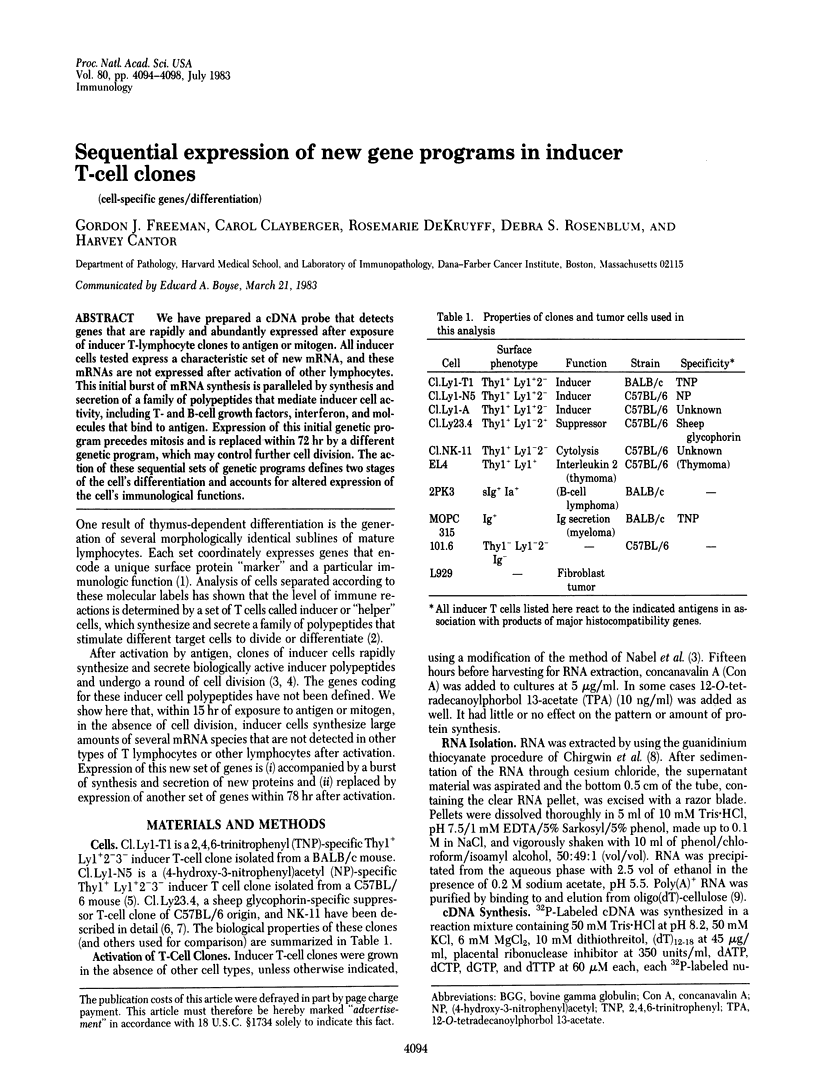
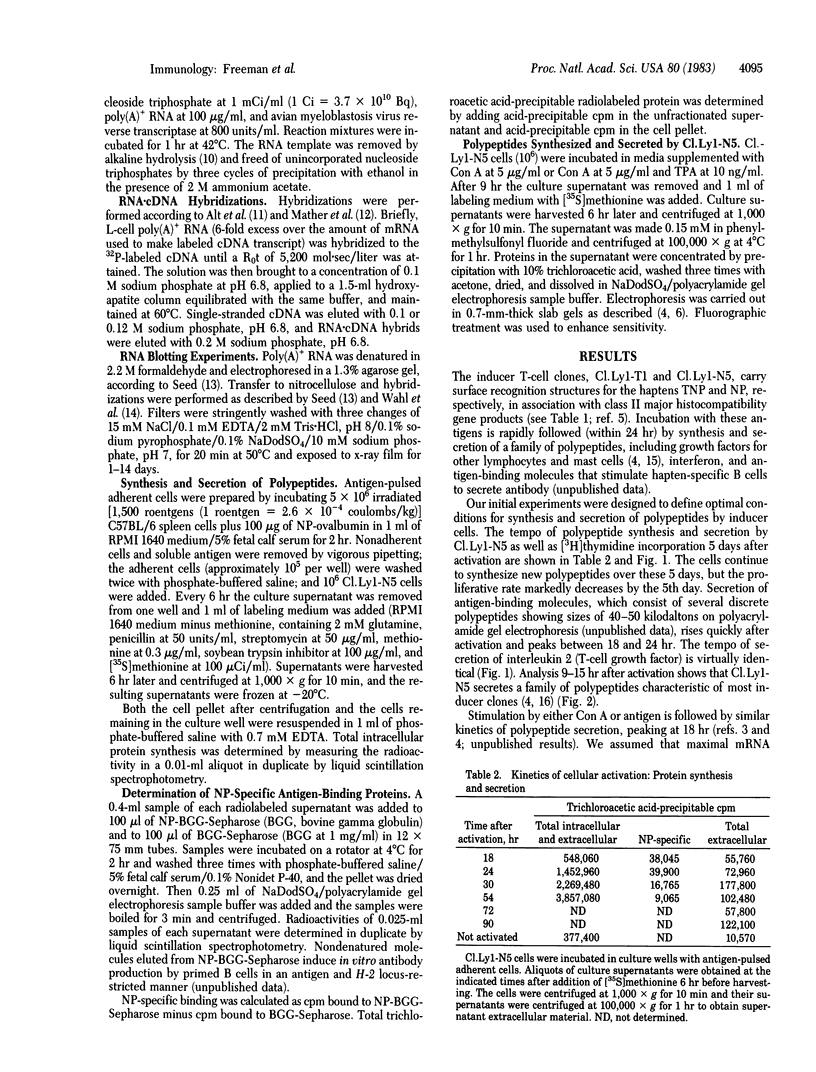
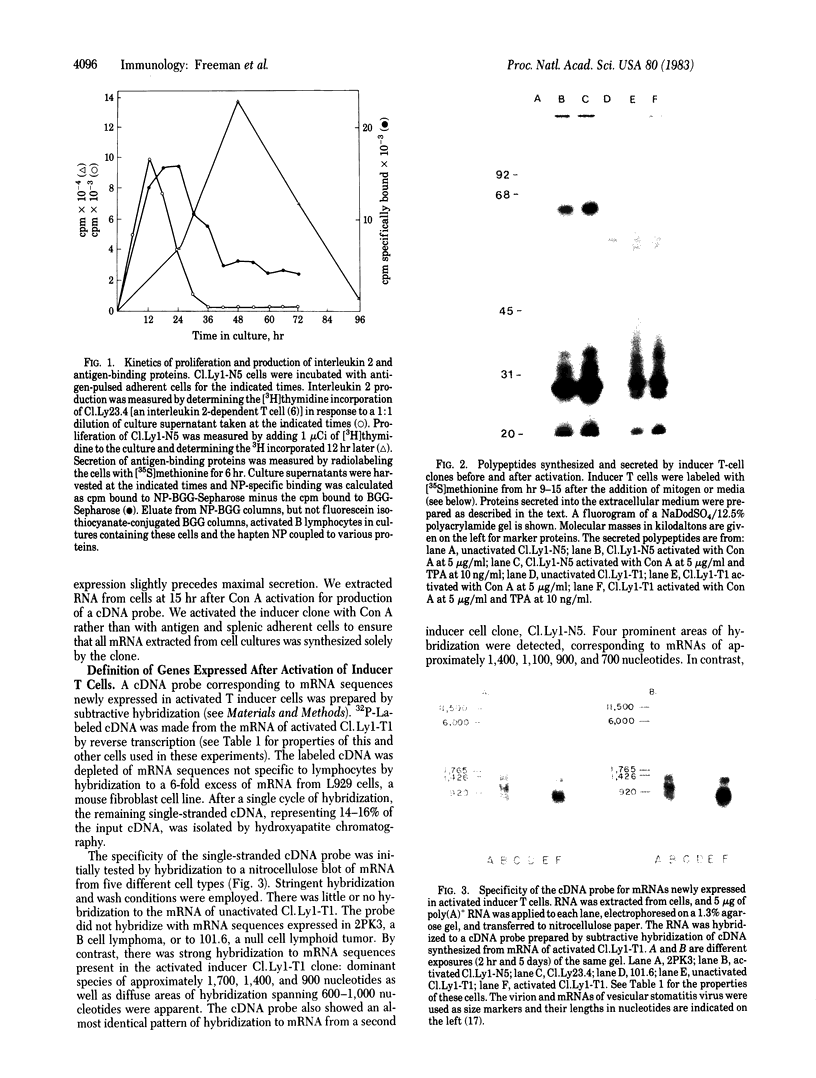
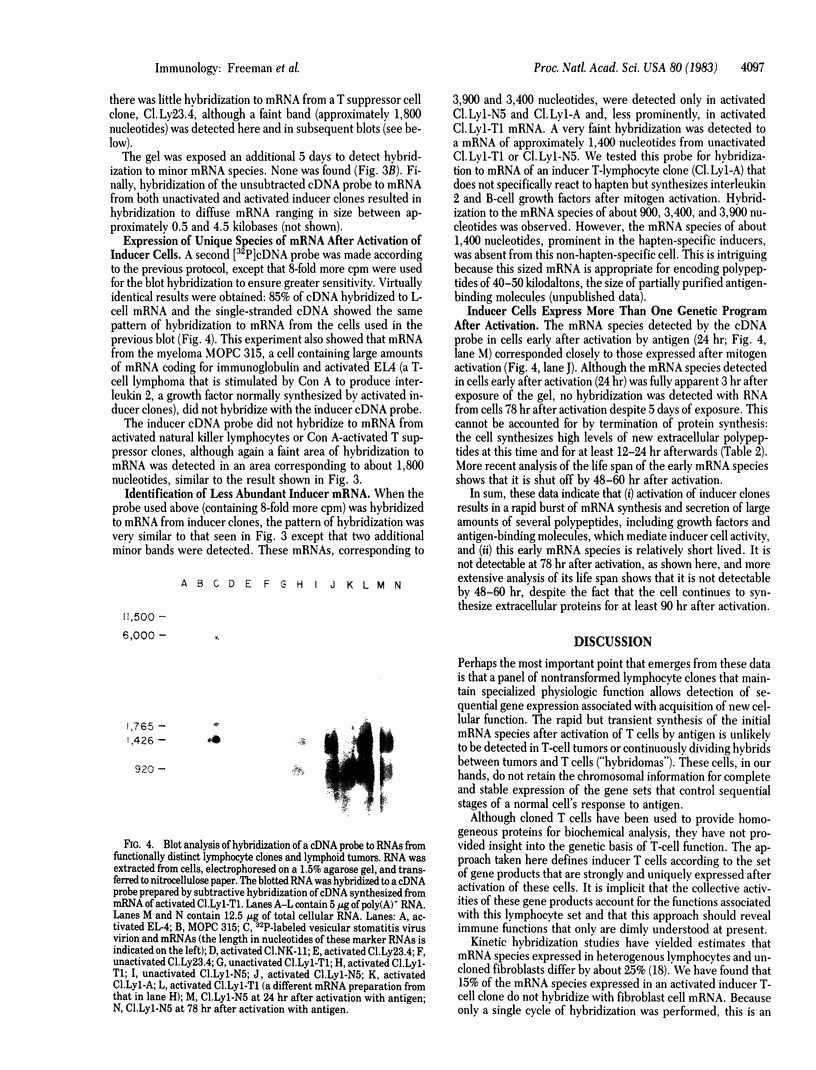
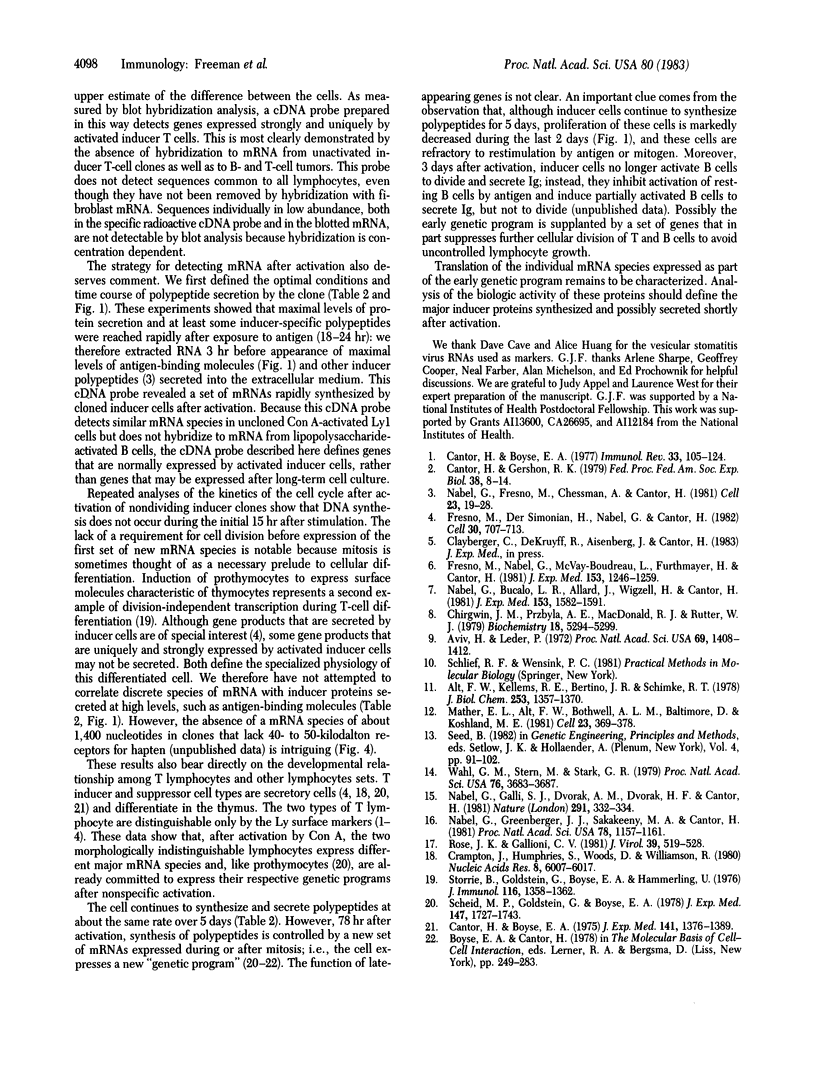
Images in this article
Selected References
These references are in PubMed. This may not be the complete list of references from this article.
- Alt F. W., Kellems R. E., Bertino J. R., Schimke R. T. Selective multiplication of dihydrofolate reductase genes in methotrexate-resistant variants of cultured murine cells. J Biol Chem. 1978 Mar 10;253(5):1357–1370. [PubMed] [Google Scholar]
- Aviv H., Leder P. Purification of biologically active globin messenger RNA by chromatography on oligothymidylic acid-cellulose. Proc Natl Acad Sci U S A. 1972 Jun;69(6):1408–1412. doi: 10.1073/pnas.69.6.1408. [DOI] [PMC free article] [PubMed] [Google Scholar]
- Cantor H., Boyse E. A. Functional subclasses of T-lymphocytes bearing different Ly antigens. I. The generation of functionally distinct T-cell subclasses is a differentiative process independent of antigen. J Exp Med. 1975 Jun 1;141(6):1376–1389. doi: 10.1084/jem.141.6.1376. [DOI] [PMC free article] [PubMed] [Google Scholar]
- Cantor H., Boyse E. A. Lymphocytes as models for the study of mammalian cellular differentiation. Immunol Rev. 1977 Jan;33:105–124. doi: 10.1111/j.1600-065x.1977.tb00364.x. [DOI] [PubMed] [Google Scholar]
- Chirgwin J. M., Przybyla A. E., MacDonald R. J., Rutter W. J. Isolation of biologically active ribonucleic acid from sources enriched in ribonuclease. Biochemistry. 1979 Nov 27;18(24):5294–5299. doi: 10.1021/bi00591a005. [DOI] [PubMed] [Google Scholar]
- Crampton J., Humphries S., Woods D., Williamson R. The isolation of cloned cDNA sequences which are differentially expressed in human lymphocytes and fibroblasts. Nucleic Acids Res. 1980 Dec 20;8(24):6007–6017. doi: 10.1093/nar/8.24.6007. [DOI] [PMC free article] [PubMed] [Google Scholar]
- Fresno M., Der Simonian H., Nabel G., Cantor H. Proteins synthesized by inducer T cells: evidence for a mitogenic peptide shared by inducer molecules that stimulate different cell types. Cell. 1982 Oct;30(3):707–713. doi: 10.1016/0092-8674(82)90275-6. [DOI] [PubMed] [Google Scholar]
- Fresno M., Nabel G., McVay-Boudreau L., Furthmayer H., Cantor H. Antigen-specific T lymphocyte clones. I. Characterization of a T lymphocyte clone expressing antigen-specific suppressive activity. J Exp Med. 1981 May 1;153(5):1246–1259. doi: 10.1084/jem.153.5.1246. [DOI] [PMC free article] [PubMed] [Google Scholar]
- Mather E. L., Alt F. W., Bothwell A. L., Baltimore D., Koshland M. E. Expression of J chain RNA in cell lines representing different stages of B lymphocyte differentiation. Cell. 1981 Feb;23(2):369–378. doi: 10.1016/0092-8674(81)90132-x. [DOI] [PubMed] [Google Scholar]
- Nabel G., Bucalo L. R., Allard J., Wigzell H., Cantor H. Multiple activities of a cloned cell line mediating natural killer cell function. J Exp Med. 1981 Jun 1;153(6):1582–1591. doi: 10.1084/jem.153.6.1582. [DOI] [PMC free article] [PubMed] [Google Scholar]
- Nabel G., Fresno M., Chessman A., Cantor H. Use of cloned populations of mouse lymphocytes to analyze cellular differentiation. Cell. 1981 Jan;23(1):19–28. doi: 10.1016/0092-8674(81)90266-x. [DOI] [PubMed] [Google Scholar]
- Nabel G., Galli S. J., Dvorak A. M., Dvorak H. F., Cantor H. Inducer T lymphocytes synthesize a factor that stimulates proliferation of cloned mast cells. Nature. 1981 May 28;291(5813):332–334. doi: 10.1038/291332a0. [DOI] [PubMed] [Google Scholar]
- Nabel G., Greenberger J. S., Sakakeeny M. A., Cantor H. Multiple biologic activities of a cloned inducer T-cell population. Proc Natl Acad Sci U S A. 1981 Feb;78(2):1157–1161. doi: 10.1073/pnas.78.2.1157. [DOI] [PMC free article] [PubMed] [Google Scholar]
- Rose J. K., Gallione C. J. Nucleotide sequences of the mRNA's encoding the vesicular stomatitis virus G and M proteins determined from cDNA clones containing the complete coding regions. J Virol. 1981 Aug;39(2):519–528. doi: 10.1128/jvi.39.2.519-528.1981. [DOI] [PMC free article] [PubMed] [Google Scholar]
- Scheid M. P., Goldstein G., Boyse E. A. The generation and regulation of lymphocyte populations: evidence from differentiative induction systems in vitro. J Exp Med. 1978 Jun 1;147(6):1727–1743. doi: 10.1084/jem.147.6.1727. [DOI] [PMC free article] [PubMed] [Google Scholar]
- Storrie B., Goldstein G., Boyse E. A., Hammerling U. Differentiation of thymocytes: evidence that induction of the surface phenotype requires transcription and translation. J Immunol. 1976 May;116(5):1358–1362. [PubMed] [Google Scholar]
- Wahl G. M., Stern M., Stark G. R. Efficient transfer of large DNA fragments from agarose gels to diazobenzyloxymethyl-paper and rapid hybridization by using dextran sulfate. Proc Natl Acad Sci U S A. 1979 Aug;76(8):3683–3687. doi: 10.1073/pnas.76.8.3683. [DOI] [PMC free article] [PubMed] [Google Scholar]





